
Arezzo is a city and comune in Italy and the capital of the province of the same name located in Tuscany. Arezzo is about 80 kilometres southeast of Florence at an elevation of 296 metres (971 ft) above sea level. As of 2022, the population was about 97,000.

Pistoia is a city and comune in the Italian region of Tuscany, the capital of a province of the same name, located about 30 kilometres (19 mi) west and north of Florence and is crossed by the Ombrone Pistoiese, a tributary of the River Arno. It is a typical Italian medieval city, and it attracts many tourists, especially in the summer. The city is famous throughout Europe for its plant nurseries.

Komenda is a village in the Upper Carniola region of Slovenia. It is the seat of the Municipality of Komenda. It includes the formerly independent settlement of Kaplja Vas.

Brestanica is an urban settlement in the Municipality of Krško in eastern Slovenia. It lies in the valley at the confluence of the Sava River with a minor tributary called the Brestanica. The area is part of the traditional region of Styria. It is now included with the rest of the municipality in the Lower Sava Statistical Region.
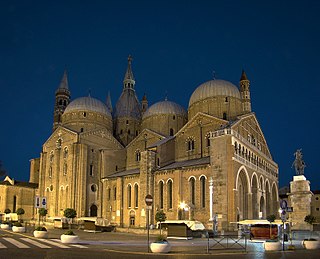
The Pontifical Basilica of Saint Anthony of Padua is a Catholic church and minor basilica in Padua, Veneto, Northern Italy, dedicated to St. Anthony of Padua.
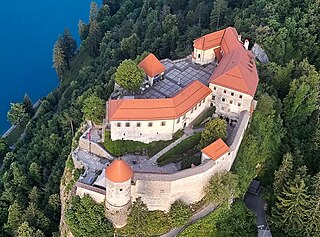
Bled Castle is a medieval castle built on a precipice above the city of Bled in Slovenia, overlooking Lake Bled. According to written sources, it is the oldest Slovenian castle and is currently one of the most visited tourist attractions in Slovenia. Nowadays, the castle is employed as a historical museum with a collection that represents the lake's history.

Ljubljana Castle is a castle complex standing on Castle Hill above downtown Ljubljana, the capital of Slovenia. It is a key landmark of the town. Originally a medieval fortress, it was probably constructed in the 11th century and rebuilt in the 12th century. It acquired its present outline with an almost complete overhaul in the 15th century, whereas the majority of the buildings date to the 16th and 17th centuries. Initially a defense structure and since the first half of the 14th century the seat of the lords of Carniola, it was since the early 19th century used for various other purposes and today is used as a major cultural venue.

The Duomo of Monza, often known in English as Monza Cathedral, is the main religious building of Monza, Italy. Unlike most duomi, it is not in fact a cathedral, as Monza has always been part of the Diocese of Milan, but is in the charge of an archpriest who has the right to certain episcopal vestments including the mitre and the ring. The church is also known as the Basilica of San Giovanni Battista from its dedication to John the Baptist.

Strmol Castle is a castle located at the foot of Dvorjanski hrib near the villages of Češnjevek, Grad and Dvorje, in the Municipality of Cerklje na Gorenjskem, Slovenia. Named after its builders, the Strmol family, it is notable as one of the few castles in Slovenia to retain a Slovene name throughout its history. It is currently a guesthouse and conference site for the government of the Republic of Slovenia.
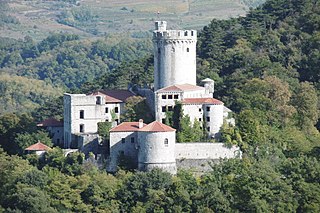
Branik Castle, also known as Rihemberk Castle, is a 13th-century castle above the village of Branik, near the city of Nova Gorica in southwestern Slovenia.

Turjak Castle is a 13th-century castle located above the settlement of Turjak, part of the municipality of Velike Lašče in the Lower Carniola region of Slovenia. The castle is 20 km southeast of Ljubljana and is considered among the most impressive in the area.

Slovenska Bistrica Castle, also known as Bistrica Castle, is a Renaissance-Baroque palace outside the town of Slovenska Bistrica in northeastern Slovenia. Its name derives from the Slovene word bistra 'clear'.

Olimje Castle is a 16th-century castle located in the settlement of Olimje, part of the Municipality of Podčetrtek in eastern Slovenia. It is currently a Franciscan monastery.

Čestice is a market town in Strakonice District in the South Bohemian Region of the Czech Republic. It has about 900 inhabitants.

The Church of Saint John of Jerusalem outside the walls is a Roman Catholic parish church in the city of Poznań in western Poland. The original church on this site was built at the end of the 11th century, making it one of the oldest churches within the present boundaries of Poznań.

St Martin's Cathedral is a cathedral in Slovakia. It is located in the town of Spišská Kapitula and is the cathedral church of the Spiš diocese.
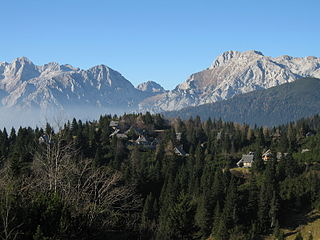
The Big Pasture Plateau is a karstified mountain plateau in the Kamnik–Savinja Alps northeast of Kamnik, Slovenia. It measures 5.8 square kilometres and has an average elevation of 1,500 metres above sea level. Its highest point is Mount Gradišče, at 1,666 m (5,466 ft). There are numerous herders' dwellings that comprise several settlement areas: Velika Planina 'Big Pasture', Mala Planina 'Little Pasture', Gojška Planina 'Gozd Pasture', Tiha Dolina 'Quiet Valley', and others. The Big Pasture Plateau is a tourist destination both in winter as a ski resort and in summer as a place for relaxation.

Saint James's Chapel is a ruined gothic chapel and surviving ossuary discovered underneath Námeste SNP in the center of Bratislava, Slovakia, in 1994. It is the oldest sacral medieval structure and the only ossuary in Bratislava.
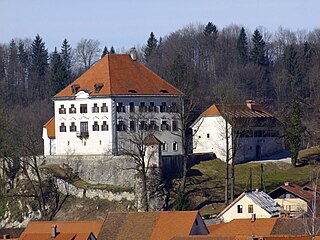
Zaprice Castle is a castle in Zaprice, now part of the town of Kamnik, Slovenia.

Stubbekøbing Church is located in Stubbekøbing some 18 km (11 mi) northeast of Nørre Alslev on the Danish island of Falster. The basilical nave was built of limestone in the Late Romanesque period. Choir and tower are of brick, the choir built in Early Gothic style, tower and the northern chapels in the 15th century in Late Gothic style. In addition to its Renaissance altarpiece and pulpit, it has a variety of old frescos and wall decorations (1300–1500).























